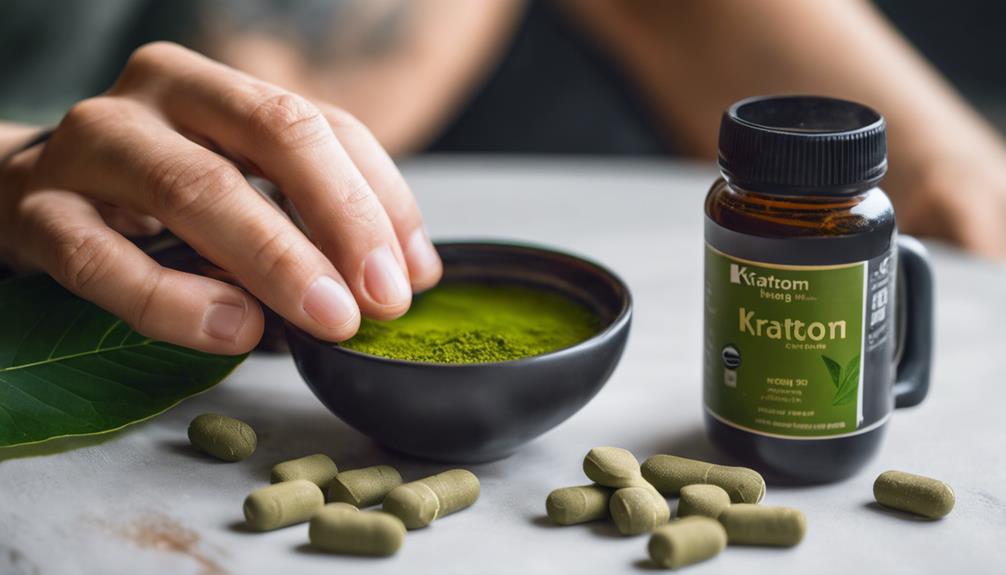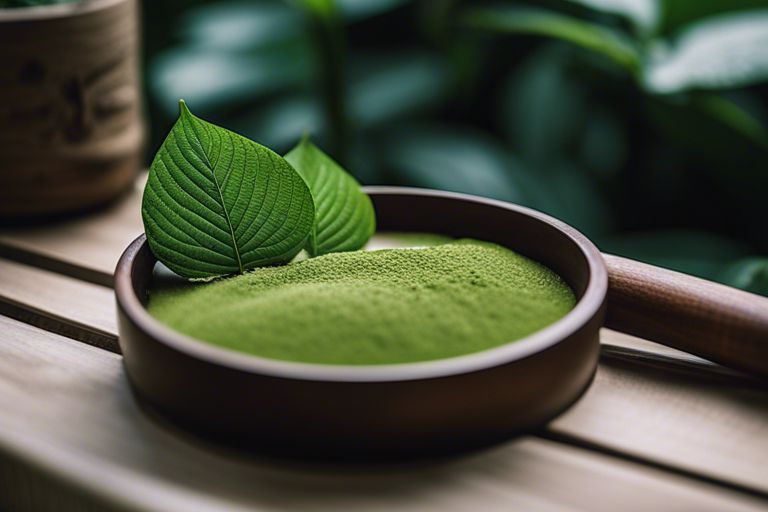Deprecated: mb_convert_encoding(): Handling HTML entities via mbstring is deprecated; use htmlspecialchars, htmlentities, or mb_encode_numericentity/mb_decode_numericentity instead in /home/users/kratomfiles/www/kratomfiles.com/wp-content/plugins/quick-adsense-reloaded/includes/template-functions.php on line 3552
If you've ever pondered the intricacies of kratom tablets, this discussion will illuminate their composition and effects. From grasping the benefits these tablets offer to learning about potential side effects and safety precautions, there's a wealth of information to explore. Delve into the world of kratom tablets to uncover how they interact with your body and what precautions you should take for a safe experience.
Key Takeaways
- Kratom tablets offer precise dosing and tailored effects for pain relief or relaxation.
- Dosage depends on tolerance and body weight; start low and space out doses.
- Side effects include nausea, constipation, sedation, and potential dependence.
- Active compounds in kratom bind to opioid receptors for pain relief and mood enhancement.
- Caution advised for side effects, dependence risk, and interactions with medical conditions or medications.
Benefits of Kratom Tablets

Exploring the benefits of kratom tablets reveals a convenient and precise method for consuming kratom, catering to individuals averse to the taste of traditional forms like tea or powder. Kratom tablets offer a straightforward way to manage dosage control, ensuring a consistent intake compared to other methods. These tablets are often formulated with specific strains or blends that target distinct effects such as pain relief, relaxation, or energy enhancement, providing users with a more tailored experience. The portability of kratom tablets allows for on-the-go use without the need for preparation, making them a practical option for those with busy lifestyles. Additionally, utilizing kratom tablets may offer a more standardized experience, ensuring users receive a reliable dose each time. Whether seeking pain relief, relaxation, or energy enhancement, kratom tablets provide a precise dosing solution that aligns with your needs while offering the convenience of a portable and standardized experience.
Proper Dosage Guidelines
To determine the appropriate dosage of kratom tablets for safe and effective use, consider factors such as individual tolerance levels, body weight, and desired effects. Beginners should start with a low dose, typically 1-2 grams of kratom tablets, to assess sensitivity and response. More experienced users may choose higher doses, around 3-5 grams, for enhanced effects, but caution is advised to prevent adverse reactions. It is vital to space out kratom tablet doses by at least 4-6 hours to avoid tolerance buildup and potential overdose risks. Consulting with a healthcare provider or a knowledgeable source is essential to establish the correct dosage of kratom tablets tailored to your specific needs. By following these dosage guidelines and seeking professional advice, you can ensure the safe and effective use of kratom tablets while maximizing the benefits and minimizing potential risks.
Potential Side Effects to Consider

Experiencing potential side effects from kratom tablets is an important consideration for individuals seeking to use this substance safely and effectively. Common side effects of kratom tablets may include nausea, dizziness, vomiting, and constipation. It is vital to be aware that some individuals might also develop allergic reactions to kratom tablets, which could manifest as skin irritation or respiratory issues. Overconsumption of kratom tablets can lead to sedation, drowsiness, and impaired coordination, underscoring the significance of adhering to recommended dosage guidelines. Prolonged and excessive use of kratom tablets may result in dependence, withdrawal symptoms, and the potential for addiction. Due to these risks, consulting a healthcare provider before using kratom tablets is essential to minimize the likelihood of adverse reactions and complications. Prioritizing caution and moderation in consumption can help individuals reap the potential benefits of kratom tablets while mitigating the associated risks.
Understanding Kratom's Mechanism of Action
When you ingest kratom tablets, the active compounds, mitragynine, and 7-hydroxymitragynine, bind to opioid receptors in your brain. This binding triggers a cascade of effects that include pain relief, sedation, and mood enhancement. Understanding how these compounds interact with your body's receptors can provide insights into the biological mechanisms behind kratom's effects.
Kratom's Biological Effects
Kratom tablets exert their biological effects by modulating opioid receptors in the brain through active alkaloids like mitragynine and 7-hydroxymitragynine. These alkaloids primarily target mu-opioid receptors, providing pain relief and sedation akin to traditional opioids. Additionally, kratom interacts with kappa-opioid receptors, producing anti-nociceptive effects. Its influence on serotonin and norepinephrine receptors contributes to mood enhancement and potential antidepressant properties. Understanding kratom's diverse receptor interactions is crucial for comprehending its therapeutic potential and associated risks when consumed in tablet form. By delving into the intricate mechanisms at play, one can appreciate how kratom's biological effects offer a nuanced approach to pain management and mood modulation.
Receptor Interactions Explained
Interacting with specific opioid receptors in the brain, kratom's active compounds, such as mitragynine and 7-hydroxymitragynine, play an essential role in modulating various biological responses. These interactions result in pain relief, sedation, and mood enhancement, akin to opioid effects. By binding to mu-opioid receptors, kratom influences neurotransmitter release, contributing to its analgesic properties. However, this mechanism also underlies its addictive potential. Understanding how kratom interacts with these receptors provides insights into both its therapeutic effects and risks. The delicate balance between exploiting kratom's benefits for pain management and mood enhancement while mitigating its addictive properties remains an important area of study for maximizing its therapeutic potential in a safe and controlled manner.
Can Kratom Tablets Help with Fibromyalgia Symptoms?
There is a growing interest in the potential kratom benefits for fibromyalgia relief. Some individuals have reported that kratom tablets have helped alleviate their fibromyalgia symptoms, such as pain and fatigue. However, more research is needed to fully understand the effectiveness and safety of using kratom for managing fibromyalgia.
Safety Precautions and Warnings

To guarantee the safe use of kratom tablets, it is essential to be aware of potential side effects and interactions that may occur. When consuming kratom tablets, individuals should be cautious of experiencing side effects such as nausea, aggression, and hallucinations. Prolonged usage of kratom may result in dependence and withdrawal symptoms similar to opioids, necessitating careful monitoring. Pregnant and breastfeeding individuals should exercise caution when considering kratom tablets due to potential risks to themselves and their babies. Additionally, certain medical conditions and medications can interact with kratom tablets, highlighting the importance of using them judiciously. It is crucial to adhere to recommended dosages and guidelines to mitigate health risks associated with kratom tablet consumption.
| Safety Concerns | Interaction with Medications | Pregnancy Precautions |
|---|---|---|
| Dependence and withdrawal | Potential interactions | Cautious use advised |
| Nausea, aggression, hallucinations | Medical conditions | Risks to mother and baby |
| Recommended dosages | Monitoring required | Potential complications |
Interactions With Other Substances
Interactions between kratom tablets and various substances can lead to significant physiological effects that necessitate careful consideration and monitoring. When combined with benzodiazepines, kratom tablets have the potential to induce sedation and respiratory depression, emphasizing the importance of avoiding concurrent use. On the other hand, mixing kratom tablets with stimulants may result in elevated heart rate and blood pressure, posing risks for individuals with cardiovascular concerns. Concurrent use of kratom tablets with opiates can enhance the likelihood of central nervous system depression, underscoring the need for caution when using these substances together. Additionally, consuming alcohol alongside kratom tablets can exacerbate sedative effects and impair cognitive function, highlighting the importance of avoiding this combination. Given the limited research available on the specific interactions of kratom tablets with other substances, seeking medical advice and approaching these combinations with caution is vital to prevent adverse effects and promote safety.










